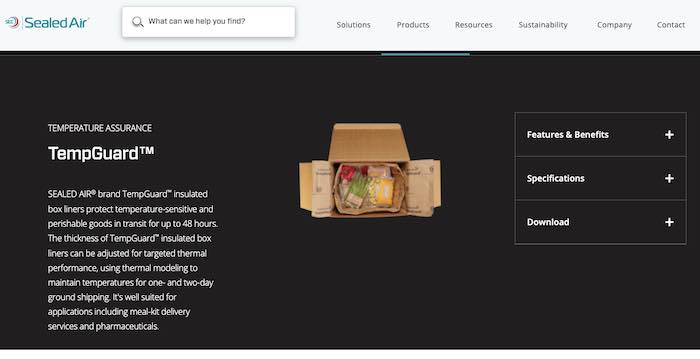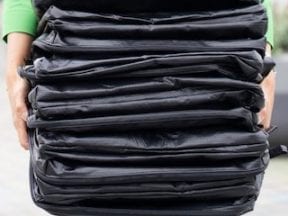Consumers concerned about waste in landfills and oceans are demanding sustainable product packaging. Environmentally responsible packaging can be just as cost-effective as conventional methods but may require a change in thinking.
Packaging is sustainable if it meets eight criteria, according (PDF) to the Sustainable Packaging Coalition:
- Beneficial, safe, healthy for individuals and communities throughout its lifecycle.
- Meets market criteria for performance and cost.
- Sourced, manufactured, transported, and recycled using renewable energy.
- Optimizes the use of renewable or recycled source materials.
- Manufactured using clean production technologies and best practices.
- Made from materials healthy throughout the lifecycle.
- Physically designed to optimize materials and energy.
- Effectively recovered and utilized in biological or industrial closed-loop cycles.
Why Sustainable Packaging?
Sustainable packaging can help your business reduce costs. The need to store materials is lessened if packages are designed and manufactured to fit your products. The same goes for shipping: Smaller parcels mean less space, leading to lower logistics expenses. And sustainable packaging can lead to loyal customers.
To implement:
Look at your current packaging. Can you use a smaller container, bag, or box and less filler? Overpackaging is a major complaint of consumers. Streamline your packaging and pallet designs using software from Esko’s Cape Systems, Tops Pro, or similar. All can help create optimal packaging sizes and shapes for your products.
Reuse and recycle packaging materials. Select packaging that uses recycled materials. Recycled cardboard and new paperboard (made from wood pulp) are lightweight. Both are easy to cut and form for making boxes. Bubble wrap made from corrugated paper can replace the plastic version. Consider cartons made from bamboo and sugarcane as well as containers made from recycled plastics.
Ritual, the multivitamin company, uses 100% recycled materials for all bottles. In 2020 Ritual recycled an amount of plastic equivalent to roughly 3 million water bottles. “We’re able to virtually ‘erase’ the shipping footprint from our warehouse to your doorstep via carbon offsetting,” states the company’s website.
Consider compostable mailers and plant-based packaging. Sustainable packaging from biological sources uses cornstarch, mushrooms — you name it. The T-Shirt Mill, an Iowa-based screen printer, ships orders in 100% compostable mailers made from wheat, straw, and other biomaterials. Jute and cotton make excellent reusable bags to deliver apparel and home accessories, for example.
SupplyCompass, a U.K.-based provider of sustainable supply-chain goods and software, states, “Our bio-based polybags have a shelf-life of 12 months and are 100 percent home compostable, disappearing in 6 months when disposed of in correct composting conditions.” Some packaging is even plantable — wrapping materials are embedded with seeds for planting at home.
Move away from plastics. Single-use virgin plastics can take up to 1,000 years to biodegrade. That is not sustainable. A much better option is biodegradable plastic, which breaks down from heat or light. However, it still uses petroleum, which makes it non-compostable. Air pillows made from recycled materials can protect delicate items and come in a variety of sizes. Sealed Air, a provider, encourages consumers to recycle its packing pillows at 18,000 retail store drop-off locations across the U.S.
Suppliers
There are many suppliers of recycled and biodegradable packaging. Look for providers that use raw materials from equally committed sources and otherwise seek to minimize their impact on the environment.
Ask for evidence of a potential supplier’s claims. Confirming those claims is important as communications to your customers must be true. Work with your chosen supplier to create unique solutions for your products.
TempGuard, a Sealed Air brand, provides 100% recyclable packaging for shipping temperature-sensitive goods. The product is constructed from heavy-duty craft paper with inner padding for superior insulating properties. Sunbasket, a San Francisco-based meal kit provider, uses TempGuard for its halibut and shrimp packaging. Adopting TempGuard has lowered Sunbasket’s shipping temperatures while reducing carton dimensions by almost 25%. The reduction enables 30% more boxes per shipment, cutting Sunbasket’s carbon footprint in distribution.

TempGuard from Sealed Air provides 100% recyclable packaging for shipping temperature-sensitive goods, such as meal kits.
Emerging suppliers are doing more than provide the packaging. Many manage the entire logistics process, including returns. LimeLoop, for example, offers durable shipping pouches from recycled billboard wraps that can be reused as many as 200 times. Co-founder Ashley Etling says it is “essential we reimagine the packaging experience” for an ecommerce economy. Merchants ship orders in LimeLoop’s reusable packaging; the customer then returns the empty packaging via USPS to reuse.
Many consumers will pay more for sustainable packaging. Although Fiona Salter at Tiny Box Company, a U.K.-based sustainable packaging provider, says the costs are affordable. “Recycled packaging doesn’t have to be expensive, quite the opposite,” she said. Her company’s small craft boxes start at just £0.28.
Taking the first steps to sustainable packaging can seem daunting. Start slowly. Order samples within your budget to test against damage. Use with a few customers to establish practicality and ease of disposal. Evaluate the results, tweak as needed, and proceed.





